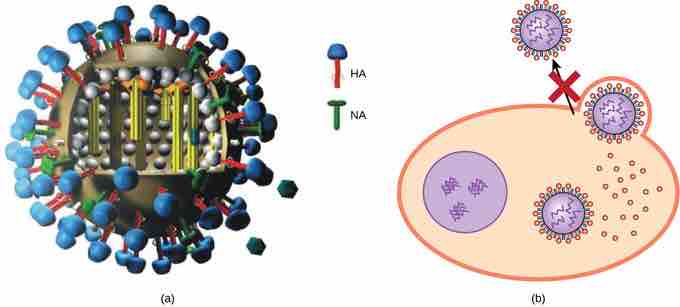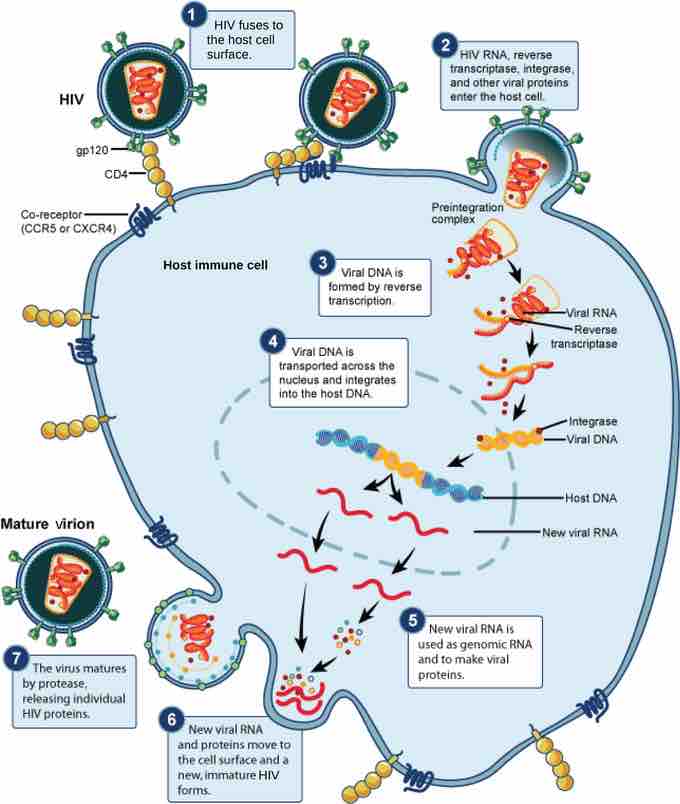Vaccines and Anti-viral Drugs for Treatment
In some cases, vaccines can be used to treat an active viral infection. The concept behind this is that by giving the vaccine, immunity is boosted without adding more disease-causing virus. In the case of rabies, a fatal neurological disease transmitted via the saliva of rabies virus-infected animals, the progression of the disease from the time of the animal bite to the time it enters the central nervous system may be two weeks or longer. This is enough time to vaccinate an individual who suspects that they have been bitten by a rabid animaL; their boosted immune response is sufficient to prevent the virus from entering nervous tissue. Thus, the potentially-fatal neurological consequences of the disease are averted; the individual only has to recover from the infected bite. This approach is also being used for the treatment of Ebola virus, one of the fastest and most deadly viruses on earth. Transmitted by bats and great apes, this disease can cause death in 70–90 percent of infected humans within two weeks. Using newly-developed vaccines that boost the immune response in this way, there is hope that affected individuals will be better able to control the virus, potentially saving a greater percentage of infected persons from a rapid and very painful death.
Another way of treating viral infections is the use of antiviral drugs. These drugs often have limited success in curing viral disease, but in many cases, they have been used to control and reduce symptoms for a wide variety of viral diseases. For most viruses, these drugs can inhibit the virus by blocking the actions of one or more of its proteins. It is important that the targeted proteins be encoded by viral genes and that these molecules are not present in a healthy host cell. In this way, viral growth is inhibited without damaging the host. There are large numbers of antiviral drugs available to treat infections, some specific for a particular virus and others that can affect multiple viruses.
Antivirals have been developed to treat genital herpes (herpes simplex II) and influenza. For genital herpes, drugs such as acyclovir can reduce the number and duration of episodes of active viral disease during which patients develop viral lesions in their skin cells. As the virus remains latent in nervous tissue of the body for life, this drug is not curative, but can make the symptoms of the disease more manageable. For influenza, drugs like Tamiflu (oseltamivir) can reduce the duration of "flu" symptoms by one or two days, but the drug does not prevent symptoms entirely . Tamiflu works by inhibiting an enzyme (viral neuraminidase) that allows new virions to leave their infected cells. Thus, Tamiflu inhibits the spread of virus from infected to uninfected cells. Other antiviral drugs, such as Ribavirin, have been used to treat a variety of viral infections, although its mechanism of action against certain viruses remains unclear.

Tamiflu
(a) Tamiflu inhibits a viral enzyme called neuraminidase (NA) found in the influenza viral envelope. (b) Neuraminidase cleaves the connection between viral hemagglutinin (HA), also found in the viral envelope, and glycoproteins on the host cell surface. Inhibition of neuraminidase prevents the virus from detaching from the host cell, thereby blocking further infection.
Anti-HIV Drugs
By far, the most successful use of antivirals has been in the treatment of the retrovirus HIV, which causes a disease that, if untreated, is usually fatal within 10–12 years after infection. Anti-HIV drugs have been able to control viral replication to the point that individuals receiving these drugs survive for a significantly longer time than the untreated.
Anti-HIV drugs inhibit viral replication at many different phases of the HIV replicative cycle . Drugs have been developed that inhibit the fusion of the HIV viral envelope with the plasma membrane of the host cell (fusion inhibitors), the conversion of its RNA genome into double-stranded DNA (reverse transcriptase inhibitors), the integration of the viral DNA into the host genome (integrase inhibitors), and the processing of viral proteins (protease inhibitors).

HIV
HIV, an enveloped, icosahedral virus, attaches to the CD4 receptor of an immune cell and fuses with the cell membrane. Viral contents are released into the cell where viral enzymes convert the single-stranded RNA genome into DNA and incorporate it into the host genome.
When any of these drugs are used individually, the high mutation rate of the virus allows it to easily and rapidly develop resistance to the drug, limiting the drug's effectiveness. The breakthrough in the treatment of HIV was the development of HAART, highly-active anti-retroviral therapy, which involves a mixture of different drugs, sometimes called a drug "cocktail." By attacking the virus at different stages of its replicative cycle, it is much more difficult for the virus to develop resistance to multiple drugs at the same time. Still, even with the use of combination HAART therapy, there is concern that, over time, the virus will develop resistance to this therapy. Thus, new anti-HIV drugs are constantly being developed with the hope of continuing the battle against this highly fatal virus.